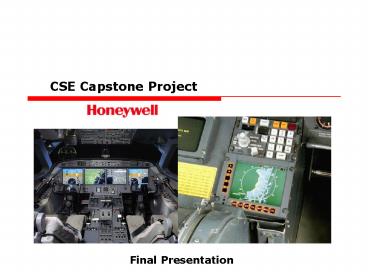CSE Capstone Project PowerPoint PPT Presentation
1 / 23
Title: CSE Capstone Project
1
CSE Capstone Project
Final Presentation
2
Honeywell Avionics Displays Group
- Display Group
- Located in Dear Valley
- Program and support cockpit displays
- Displays are responsible for reporting various
important flight information - Altitude, Speed, Pitch, etc.
- Project Managers
- Malachi Nordine
- Mohammed Islam
3
The Hardware
- Two main components
- Display Unit (DU) Displays flight information
in 2-D graphics. - Advanced Graphics Module (AGM) The graphics
engine which uses OpenGL libraries to draw
primitives to one or more displays.
4
Project Overview
- The purpose
- Create a remote testing tool for the new advanced
graphics module (AGM-200). - Testing tool checks for consistency for all
primitives drawn by AGM-200. - The approach
- Set up a client-server network between a remote
PC and the AGM-200. - Commands
- Draw an OpenGL primitive.
- Retrieve corresponding CRC value.
5
System Level Overview
6
Documentation
- Honeywells protocol for doing documentation
- Requirements SRS (System Requirement
Specification) - Design SRDD (System Requirement Design Document)
- Testing Test Plan
- Goal
- Lower levels of documentation trace back to
higher levels of documentation for requirement
verification - Test Plan test cases -gt SRDD requirements -gt SRS
requirements
7
SRS - Overview
- The SRS focuses on the system-level requirements
(the what), non implementation specific. - System Overview
- General System Requirements
- Quality Requirements
- System Interface Requirements
8
SRS General System Requirements
- Main focus of SRS general system requirements
- Provide abstract non implementation specific
description of each requirement - Provide test cases for each requirement
- Represented by shall statements, must be
testable - Each shall statement has a trace tag
9
SRDD - Overview
- SRDD focuses on the lower-level implementation
-specific requirements (the how) - It is a list of methods and classes that will
eventually be implemented - Specific enough to explain exactly what a
function does - Abstract enough so the programmer can implement
the code anyway they want
10
SRDD Example Function
- setPrimitive tells the AGM-200 which drawing mode
to be in. - SRDD shall statements trace back to SRS
11
Test Plan
- Test plan is the lowest level in the
documentation hierarchy. - The document is organized as a listing of test
cases which correspond to all of the shall
statements in the SRDD. - Not actual code, but descriptions of code that
you will write that gives the coder freedom of
implementation.
12
Client
- Layered Design
- Client
- Transactions / Requests
- GUI / Test Runner
- Network
- Decided to use UDP, but left TCP functionality in
as product switch
13
GUI
14
Output
tcpClient.fixtures.TransactionFixture tcpClient.fixtures.TransactionFixture tcpClient.fixtures.TransactionFixture
IP port Start?
agm 6969 true
tcpClient.fixtures.GenericRequestFixture DrawSquare
GetReply?
true
tcpClient.fixtures.GenericRequestFixture SetColorFlat SetColorFlat SetColorFlat
RR GG BB GetReply?
22 33 FF true
tcpClient.fixtures.GenericRequestFixture GetCRC
GetReply?
0x7C4237D7
15
Class Structure
- AGM_Client.jar
- package fit
- package displayTool
- DisplayFrame.java, DisplayTool.java
- package tcpClient
- NetClient.java, TCPClient.java, UDPClient.java
- Request.java, Reply.java, Transaction.java
- TestRunner.java
- package fixtures
- GenericRequestFixture.java
- TransactionFixture.java
- TCPApplet.java
16
Server Environment
- Ran on the DEOS operating system
- Proprietary real-time scheduling OS
- Written in C
- Time consuming setting up server project in
visual studio - Memory, scheduling, threads, mutexes, mailboxes,
etc. all entered manually into registry - Binary file and registry uploaded to the AGM
using ftpshell and then ran - Debugging done through logProcessEvents and
checked through telnet
17
Server Processes
- We use two processes
- CRC
- aClient
- aClient has multiple threads
- Handle UDP connection
- Draw HGL primitives
- Receive a message from CRC process when the value
of the CRC has changed
18
Client/Server Communication
- Server waits for incoming UDP connection from
client - Server receives string in following format using
recvfrom() - FunctionParam1Param2ParamN
- Unpack() parses it and reads parameters into an
array of strings - Switch used to either change what is drawn or get
a CRC value - sendto() is used to send status or CRC back to
client
19
CRC Operation
- CRC is calculated using a different process.
- DEOS only allows server processes to interact
with our process, and CRC calculation is not a
server process (HGL is) - To get around this, we use a mailbox that is
accessed by our main process. - CRC sends a new value to the mailbox each time it
changes - Thread in main process keeps checking mailbox and
stores value in global variable
20
OpenGL
- Standard specification defining a cross-platform
graphics API - Doesnt provide the actual functionality only an
interface - Useful for abstraction and uniformity
- Displays use OpenGL to convert geometric
primitives (lines, shapes, etc) into pixels
21
HGL
- Supported functions
- Draw Line
- Draw Square
- Draw Triangle
- Draw Polygon
- Clear Display
- Set Color
22
Conclusion
- Had some holdups along the way due to environment
- We had to narrow the scope a bit, but in the end
we built a working product - Opportunity to learn a thing or two about
graphics, embedded software, and network
programming
23
Questions?

